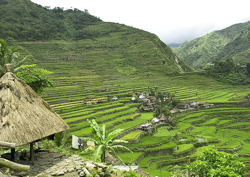Property Rights, Collective Action, and Local Conservation of Genetic Resources.
Another blogger in China
Looks like Jeremy is not the only foreigner with an interest in agriculture blogging his way around China. Jim Harkness, president of the Institute for Agriculture and Trade Policy 1 “is blogging from China as he meets with experts on China’s food and farm system.” I wonder if he and Jeremy will meet up somewhere? If they do, I bet it will be at a market or banquet.
Food politics links
There are links to a whole bunch of interesting stuff on “Why our food choices matter” on bookforum.com today.
Lose the farmers, lose the environment
 Further to Luigi’s thoughtful article on how hard farming is becoming, and how the skills needed to farm effectively are being lost as young people abandon rural life for the city, news that a farming environment often considered the eighth wonder of the world is under threat. The Banaue Rice Terraces of Luzon in the Philippines are beyond words. But they are apparently being destroyed by giant earthworms and edible snails, among other pests. But honestly, if the people are introducing snails to supplement their diet, how sustainable can the terraces possibly be? Only human labour can sustain such artifice, and only human need can command and coordinate that much labour. The President of the Philippine Senate has called for a “comprehensive study”. But what is it likely to recommend? That maintaining the terraces be a government-funded job to keep a tourist attraction in a state that will attract tourists, and their cash? Or can the communities that have inherited the Banaue terraces somehow be shown ways in which they can benefit directly from the tourist cash?
Further to Luigi’s thoughtful article on how hard farming is becoming, and how the skills needed to farm effectively are being lost as young people abandon rural life for the city, news that a farming environment often considered the eighth wonder of the world is under threat. The Banaue Rice Terraces of Luzon in the Philippines are beyond words. But they are apparently being destroyed by giant earthworms and edible snails, among other pests. But honestly, if the people are introducing snails to supplement their diet, how sustainable can the terraces possibly be? Only human labour can sustain such artifice, and only human need can command and coordinate that much labour. The President of the Philippine Senate has called for a “comprehensive study”. But what is it likely to recommend? That maintaining the terraces be a government-funded job to keep a tourist attraction in a state that will attract tourists, and their cash? Or can the communities that have inherited the Banaue terraces somehow be shown ways in which they can benefit directly from the tourist cash?
Photo from Wayfaring Travel Guide (because Flickr doesn’t work too well here in China.)
China losing biodiversity “at a frightening rate”
Land in Beijing, mind at one in the morning, the rest of the world at 7, get to the waiting lounge, discover free wireless, scan internets, discover — hold the front page — that China is losing biodiversity extremely rapidly. A thoughtful piece in the Asia Times uses the demise of the Yangtze River Dolphin to take quite a detailed look at why conservation does not seem to get any traction here. Turf wars between ministries seem to be the prime reason. There’s little talk of agriculture (I know, we sound like a cracked record 2 on this) aside from a very brief mention of ecosystem services. The fact is, China’s agriculture is among the oldest in the world, and the menu must be among the most diverse, but all the indications are that they are no longer growing the diversity they used to and that they are eating much of the animal diversity into extinction.
I’m on my way to Kunming, to see at first hand some exciting projects that make use of agricultural biodiversity to improve livelihoods. If connectivity there is as good and easy as it is here, and if I have the time, I’ll be sure to report here.